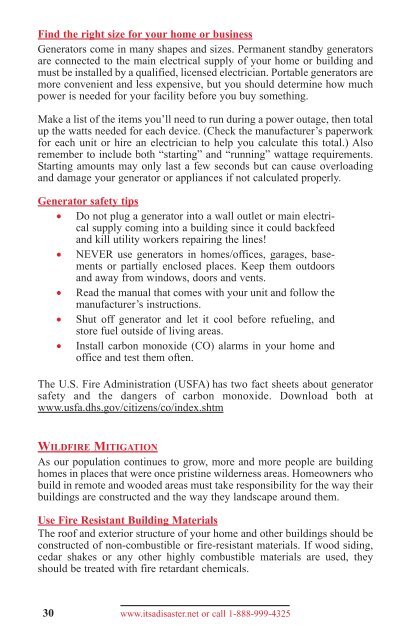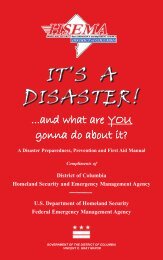disaster 5th 1108_5th ed 2011 - Homeland Security and Emergency ...
disaster 5th 1108_5th ed 2011 - Homeland Security and Emergency ...
disaster 5th 1108_5th ed 2011 - Homeland Security and Emergency ...
You also want an ePaper? Increase the reach of your titles
YUMPU automatically turns print PDFs into web optimized ePapers that Google loves.
Find the right size for your home or business<br />
Generators come in many shapes <strong>and</strong> sizes. Permanent st<strong>and</strong>by generators<br />
are connect<strong>ed</strong> to the main electrical supply of your home or building <strong>and</strong><br />
must be install<strong>ed</strong> by a qualifi<strong>ed</strong>, licens<strong>ed</strong> electrician. Portable generators are<br />
more convenient <strong>and</strong> less expensive, but you should determine how much<br />
power is ne<strong>ed</strong><strong>ed</strong> for your facility before you buy something.<br />
Make a list of the items you’ll ne<strong>ed</strong> to run during a power outage, then total<br />
up the watts ne<strong>ed</strong><strong>ed</strong> for each device. (Check the manufacturer’s paperwork<br />
for each unit or hire an electrician to help you calculate this total.) Also<br />
remember to include both “starting” <strong>and</strong> “running” wattage requirements.<br />
Starting amounts may only last a few seconds but can cause overloading<br />
<strong>and</strong> damage your generator or appliances if not calculat<strong>ed</strong> properly.<br />
Generator safety tips<br />
• Do not plug a generator into a wall outlet or main electrical<br />
supply coming into a building since it could backfe<strong>ed</strong><br />
<strong>and</strong> kill utility workers repairing the lines!<br />
• NEVER use generators in homes/offices, garages, basements<br />
or partially enclos<strong>ed</strong> places. Keep them outdoors<br />
<strong>and</strong> away from windows, doors <strong>and</strong> vents.<br />
• Read the manual that comes with your unit <strong>and</strong> follow the<br />
manufacturer’s instructions.<br />
• Shut off generator <strong>and</strong> let it cool before refueling, <strong>and</strong><br />
store fuel outside of living areas.<br />
• Install carbon monoxide (CO) alarms in your home <strong>and</strong><br />
office <strong>and</strong> test them often.<br />
The U.S. Fire Administration (USFA) has two fact sheets about generator<br />
safety <strong>and</strong> the dangers of carbon monoxide. Download both at<br />
www.usfa.dhs.gov/citizens/co/index.shtm<br />
WILDFIRE MITIGATION<br />
As our population continues to grow, more <strong>and</strong> more people are building<br />
homes in places that were once pristine wilderness areas. Homeowners who<br />
build in remote <strong>and</strong> wood<strong>ed</strong> areas must take responsibility for the way their<br />
buildings are construct<strong>ed</strong> <strong>and</strong> the way they l<strong>and</strong>scape around them.<br />
Use Fire Resistant Building Materials<br />
The roof <strong>and</strong> exterior structure of your home <strong>and</strong> other buildings should be<br />
construct<strong>ed</strong> of non-combustible or fire-resistant materials. If wood siding,<br />
c<strong>ed</strong>ar shakes or any other highly combustible materials are us<strong>ed</strong>, they<br />
should be treat<strong>ed</strong> with fire retardant chemicals.<br />
30 www.itsa<strong>disaster</strong>.net or call 1-888-999-4325





